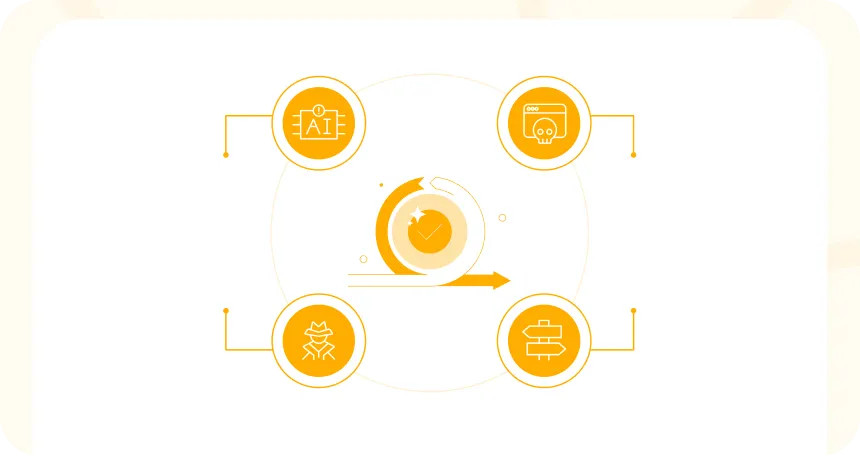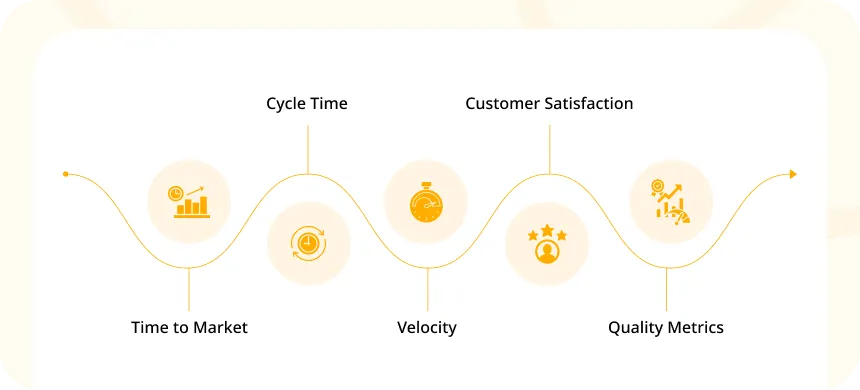Are you having trouble getting your product to clients on time?
If yes, then this blog post can offer a helpful solution for you.
In the constantly evolving tech world where offshore software development is on the rise, quickly delivering high-quality software can make or break your business.
The pressure of delivering innovative & good-quality software products at an accelerated pace has never been more significant than today.
This is where Agile software development comes in. It is a dynamic and iterative approach to transforming how companies bring their products to market.
Agile speeds up the development cycle and ensures that the final software product aligns closely with user needs & market demands. This methodology fosters:
- Collaboration
- Flexibility
- Continuous improvement
- Efficiency
Let’s begin by understanding what exactly Agile software development is and how adopting Agile principles can significantly reduce time to market, give businesses a competitive edge, and reduce time to market to drive success.
Understanding Agile Software Development
Agile methodology is defined as the popular approach in the field of software development that mainly focuses on collaboration, flexibility, and customer-centricity. It focuses on iterative progress through small, manageable increments.
This allows dedicated Agile teams to adapt to changing requirements & deliver value to customers more quickly & efficiently.
Key Principles & Values of Agile
Here is the list of key principles involved in Agile software development:
- Iterative Development: Agile methodology promotes breaking down the software development process into smaller i.e. iterative sprints or iterations. Each iteration involves designing, planning, developing, and testing a small functionality.
- Collaboration: One of Agile’s core values is fostering close collaboration among cross-functional teams. Developers, testers, designers, and stakeholders work together during the entire project. They also ensure everyone is aligned & contribute expertise.
- Flexibility: Agile teams often adjust their plans quickly and priorities as project requirements evolve based on customer feedback or market changes. This type of flexibility helps respond to new insights without disrupting the overall project flow.
- Focus on Customers: Agile emphasizes delivering value to the customer. Agile teams also ensure that the final software product meets users’ needs &expectations. This iterative feedback loop helps refine features and functionalities based on real-world usage and feedback.
Leverage Agile software development for faster delivery.
Comparison with Traditional Software Development Methods
By comparing Agile approach with other traditional methods, it will become clear how Agile’s adaptive & responsive nature can accelerate time to market. This will ensure that the software effectively meets user needs & market demands.
1. Agile vs Waterfall: Traditional software development methods i.e. the Waterfall model, follow a linear & sequential approach. Each phase (in terms of requirements, design, development, testing, and rapid deployment) must be completed before moving towards the next.
This further leads to long development cycles and challenges accommodating changes once a phase is completed.
2. Predictability vs. Flexibility: While traditional methods offer predictability & structured planning, they often lack the flexibility to adapt to these changes. Conversely, Agile embraces change & uncertainty. This allows teams to pivot and make adjustments as needed.
This makes Agile particularly well-suited for projects with evolving requirements.
3. Feedback Cycles: In traditional methods, feedback typically comes late in the process, often during the testing phase or after deployment. Agile incorporates regular feedback throughout the development cycle, enabling continuous improvement and early identification of issues.
This reduces the risk of major problems emerging late in the project.
Importance of Time to Market for Businesses
TTM i.e. Time-to-Market, refers to the time it takes from the initial concept of a product until it becomes fully available for sale. This involves the entire process from ideation, development, and design testing to the final launch.
Impact of Shorter Time to Market on Business Success
Top software development companies can capture market opportunities, stay ahead of competitors, enhance revenue, and build a more adaptable and resilient organization by accelerating TTM.
- Capture Market Opportunities: The ability to launch products quickly allows businesses to capitalize on market trends and consumer needs as they arise. Early movers often gain a competitive advantage i.e. capturing market share before others and collect a chance to enter the field.
- Stay Ahead of Competitors: In this big competitive market, being the first to deliver a new product/feature can set your business apart from the competitors. It establishes the brand as a leader & innovator, which attract customers and build loyalty.
- Profitability: A faster TTM often directly impacts a company’s reputation in the market. Businesses can start generating revenue earlier by getting products to market sooner. This ultimately improves cash flow & profitability.
- Adaptability & Resilience: Companies that excel at reduced TTM are typically more adaptable & resilient. They respond to disruptions viz. shifts in consumer behavior, technological advancements etc. more effectively.
Also read: Top 25 Custom Software Development Companies Offering Bespoke Solutions
Core Practices of Agile Development
By adopting the following core Agile practices, organizations can significantly accelerate their time to market.
These practices further ensure that software product is delivered quickly, reliably, and aligned with customer needs, giving businesses a competitive edge.
1. Iterative Development
Using this approach, businesses get functional software into the hands of users faster & continuously improve it based on real-world use.
- Small & Workable Increments: Iterative development approach is a hallmark of Agile methodology. Using this, software is delivered in small and workable increments called “sprints”. Each sprint usually lasts 2-4 weeks & majorly focuses on delivering a specific set of features. Software development teams quickly show progress, receive feedback, and make necessary adjustments after breaking down the project into smaller parts.
- Speed & Flexibility: This approach speeds up the software development process by allowing teams to handle manageable pieces of the project one at a time. It also provides the flexibility to pivot & adapt to changing requirements or priorities without disturbing the entire project plan.
2. Continuous Integration/Continuous Delivery 
By incorporating CI/CD, Agile teams can release new features and fixes to customers quickly, maintaining a steady flow of improvements.
- Quick & Reliable Releases: CI/CD practices are essential as they ensure that new code changes are integrated & delivered rapidly/reliably. Continuous Integration involves developers frequently merge their own code changes into a shared repository, where automated tests are run to detect any issues early.
- Automated Deployments: Continuous Delivery extends this process by automating the rapid deployment of code to production environments. This reduces the risk of manual errors, speeds up release cycles, and also ensures that software updates are consistent & reliable.
3. Cross-Functional Teams
With the help of cross-functional teams, you can grow your business at the right speed carrying the desired outputs.
- Collaborative Decision-Making: The agile approach thrives on the collaboration of cross-functional teams. The team includes developers, designers, product owners, testers, and other stakeholders. These self-organizing teams work closely together, share knowledge and carry expertise to make informed decisions quickly.
- Enhanced Efficiency: The diverse skill sets within cross-functional teams enable them to address various aspects of software development concurrently. This reduces bottlenecks & software development delays. This collaboration also enhances the software team’s ability to innovate, solve problems, and deliver high-quality software products faster.
Implement Agile practices to speed up time to market.
4. Regular Feedback Loops
This approach accelerates time to market by focusing efforts on what actually matters to the end-users.
- Continuous Customer Feedback: Agile emphasizes the importance of regular feedback loops with customers and stakeholders. Through practices like sprint reviews and customer demos, teams gather feedback on the delivered increments and make necessary adjustments in subsequent sprints.
- Product Refinement: The continuous user feedback helps in refining & improving the product efficiently. By regularly incorporating user feedback, Agile development teams ensure that the software product meets customer needs/expectations, thus, reducing the risk of developing features that don’t add value.
Also read: Complete Guide To Software Development Services – A Must-Read!
Tools/Techniques for Agile Development
Agile software development utilizes various tools/techniques to facilitate faster project management by providing features that support tracking, planning, and collaboration.
Popular Agile Tools
Here is the list of some popular tools used by developers for Agile software development:
1. Jira: Jira is one of the most widely used Agile project management tools. It helps software teams plan, track, and release software products efficiently. With features like
- Customizable workflows
- Sprint planning
- Real-time reporting
Jira enables teams to manage tasks, track progress, and quickly adapt to changes. Its robust integration capabilities with other development tools further streamline the Agile process.
2. Trello: Trello is a user-friendly and visual project management tool that utilizes boards, lists, and cards to help software teams organize & prioritize tasks. It is particularly effective for smaller teams or simpler projects.
Its flexibility allows teams to create customized workflows & collaborate easily. Hence, it is a popular choice for accelerated development.
3. Asana: Asana is a versatile project management tool that supports Agile methodologies through various features viz. Timelines, task assignments, and project tracking. It helps teams
- Coordinate their work
- Track project milestones
- Ensure that everyone stays aligned with project goals
Its intuitive interface & powerful collaboration features facilitate efficient project management and task completion.
Techniques That Help Manage Workflows and Improve Efficiency
Techniques viz. Scrum, and Kanban help manage workflows and improve efficiency by structuring work into manageable increments & visualizing progress.
1. Scrum: It is a popular and well-known Agile framework that focuses on iterative development and incremental delivery. It divides the work into sprints, which are time-boxed product iterations typically lasting 2-4 weeks. Key roles in Scrum include:
- Product Owner
- Scrum Master
- Development Team
Regular ceremonies viz. Daily Stand-ups, Sprint Planning, Sprint Reviews, and Retrospectives ensure continuous improvement & effective collaboration. Its emphasis on regular feedback & adaptability helps teams deliver high-quality products faster.
2. Kanban: It is another Agile technique for visualizing workflows to improve efficiency & productivity. It uses a Kanban board with columns representing different workflow stages (e.g., In Progress, To Do, Done).
Here, the task numbers are represented by cards that move across the board as they progress through the stages. It focuses on limiting work in progress to avoid overloading team members & ensure a smooth, continuous flow of tasks.
By making the workflow visible, Kanban helps software teams identify bottlenecks & optimize their processes.
Achieve faster releases with Agile methodology.
Success Stories
The following case studies demonstrate how leading companies have successfully accelerated their time to market using Agile software development services. Have a look at these case studies below:
1. Spotify
It is the global leader in music streaming nowadays. It has utilized Agile methodologies effectively in order to accelerate their time-to-market. By adopting a unique Agile framework such as the Spotify Model, the company divided its software teams into small & autonomous units called “squads”.
Each squad works on a specific aspect of the software product & operates like a mini-startup, with the freedom to decide its own way of working.
Key Takeaways
- Autonomy & Alignment: It gives software teams the autonomy to make decisions quickly while ensuring alignment with overall company goals. It significantly boosts productivity & innovation.
- Continuous Improvement: Regular retrospectives & a culture of continuous improvement help software development teams quickly identify and resolve issues, thus, leading to faster delivery cycles.
2. ING Bank
It is known as a major global bank. It has transitioned to an Agile way of working to enhance its responsiveness & speed to market.
The bank implemented an Agile approach at scale across its IT & business departments, breaking down traditional methods and boosting closer collaboration between different functions.
Key Takeaways
- Cross-Functional Collaboration: By making cross-functional teams, ING was able to reduce handoffs, streamline processes, and accelerate project delivery.
- Customer-Centric Approach: Focusing on customer needs & iterating based on their feedback enabled ING to deliver more relevant & timely banking solutions.
3. Netflix
It is known as the streaming giant of this digital world. It leverages Agile methodologies to innovate & release new features in minimum time. The company’s culture of “Freedom & Responsibility” empowers its employees to take ownership of their projects and make rapid decisions.
Key Takeaways
- Empowerment & Trust: Trusting software teams to take responsibility & providing them with the freedom to innovate. This can lead to faster problem-solving & product enhancements.
- Data-Driven Decisions: Netflix’s use of data analytics to guide development priorities ensures that the most valuable features are prioritized & delivered quickly.
4. Amazon
Amazon employs Agile principles to maintain its position as a leader in eCommerce & cloud computing. The company uses a customer-centric approach and continuously iterating on its products and Agile consulting services based on user feedback.
Key Takeaways
- Customer Focus: It allows to keep the customer at the center of development efforts and ensures that the products and features delivered meet actual user needs, reducing the time spent on unnecessary work.
- Iterative Releases: Frequent, small releases allow Amazon to test and validate ideas quickly, reducing time to market and minimizing risk.
Challenges & Solutions in Agile Implementation
Many companies successfully adopted Agile methodologies to accelerate their time to market, and achieve sustainable success by addressing the following common challenges with their practical solutions.
Challenge 1: Resistance to Change
One of the most common challenges in Agile transformation & implementation is resistance to change. Some software team members & stakeholders are accustomed to traditional project management methods & may resist adopting Agile practices.
Impact: Resistance may slow down the adoption process. This leads to friction within teams and hindering the benefits. Agile approach provides benefits, such as faster time to market and improved responsiveness.
Solution:
- Change Management: It involves clear communication about the reasons for adopting Agile methodology, the benefits it brings, and how it will impact software teams & stakeholders. Engaging stakeholders early in the process & addressing their issues can help you alleviate resistance.
- Training & Education: Providing Agile training & workshops for software teams and stakeholders help them understand the principles & practices of Agile methodology. The education can further build confidence & increase acceptance of Agile software development.
Challenge 2: Lack of Agile Expertise
Another challenge is the lack of Agile software development expertise among developers within the organization. It requires a different mindset as well as skill set compared to traditional project management. And, not having the necessary expertise can definitely lead to implementation challenges.
Impact: Without Agile development expertise, software teams may struggle to effectively implement Agile practices. This results in inefficient processes and slower delivery times.
Solution:
- Hiring Agile Coaches: Bringing in experienced Agile consultants can provide guidance & mentorship to different teams. Coaches help tailor Agile practices to the organization’s specific needs, provide training, and facilitate the transition.
- Internal Training Programs: Establishing internal training programs to upskill existing software development members in Agile methodologies can also be effective. This ensures that everyone understands Agile principles & practices. It further fosters a culture of continuous improvement.
Challenge 3: Organizational Culture & Structure
Organizational culture & structure that are not conducive to Agile development methodology comes with some significant challenges. Hierarchical structures, siloed departments, and rigid processes, can hinder collaboration & flexibility.
Impact: The above discussed factors may slow down decision-making, limit communication, and make it difficult to adapt to changes in project requirements.
Solution:
- Adopting Agile Principles: Organizations should adopt some Agile principles viz. collaboration, transparency, and adaptability. This involves restructuring software teams into cross-functional units that can work independently and collaboratively.
- Leadership Support: Leadership support is crucial in boosting an Agile development culture. Leaders should champion Agile practices, empower teams to make decisions, and encourage experimentation & learning.
Embrace Agile software development for quick results.
How to Measure Success in Agile Development?

The success in Agile software development projects can be measured through key performance indicators that ultimately provide insights into the effectiveness of Agile methodologies in accelerating time-to-market and delivering high-value to customers.
1. Time to Market
Time-to-market measures the total duration it takes from the initiation of a software project to the release of the final software product or feature. It reflects how quickly the development team can deliver value to customers.
2. Cycle Time
Cycle time can be calculated as the average time it takes to do a task or user story to move from the beginning (i.e.being added to a sprint backlog) to completion (i.e.being deployed to production).
3. Velocity
Velocity is defined as the measure of the amount of work done by a software development team in a sprint. It is typically expressed as the number of story points or tasks completed per sprint.
4. Customer Satisfaction
Customer satisfaction can be measured through direct user feedback, surveys, Net promoter Score, or considering other customer satisfaction metrics.
5. Quality Metrics
Quality metrics include metrics related to software quality viz. defect density, escape rate (bugs found after release), and code coverage.
Future Trends in Agile Software Development
Various innovative practices & the integration of new technologies like AI, ML, blockchain, and IoT mark the bright future of Agile software development. These advancements further enhance the speed, efficiency, and effectiveness of Agile methodologies, thus enabling organizations to
- Accelerate time-to-market
- Improve product quality
- Maintain a competitive edge
Have a look at the following emerging trends in Agile software development:
Scaled Agile Frameworks (SAFe)
SAFe is a structured approach to scale Agile that enables organizations to maintain flexibility while managing complex projects.
Scaled Agile Framework (SAFe) is becoming increasingly popular for large-scale Agile implementations among businesses. It extends Agile principles to the enterprise level, promoting alignment, collaboration, and delivery across multiple software teams.
DevOps Integration
DevOps practices mainly focus on integrating development & operations teams to improve collaboration, automate workflows, and deliver software more frequently/reliably.
Agile & DevOps complement each other, with Agile focusing on rapid development and flexibility, and DevOps to focus on continuous integration & deployment.
Lean Agile Principles
Lean Agile principles emphasize reducing waste & maximizing value delivery. Techniques like Lean startup methodologies, which prioritize experimentation & customer feedback, are becoming integral to Agile practices.
Also read: Agile Software Development Is Best For Modern Businesses
Conclusion
So far we have seen that embracing Agile software development is more than just a strategic approach. It is a transformative technology that empowers software teams to deliver high-quality products swiftly & efficiently.
By spreading a culture of continuous improvement, collaboration, and adaptability, Agile methodology enables businesses to meet market demands with agility & precision.
As the pace of innovation accelerates, those who leverage Agile methodologies will find themselves better equipped to handle the complexities of the software development industry, ultimately achieving faster time-to-market and a significant competitive advantage.
Ready to accelerate your software product delivery? It is the right time to go Agile with ValueCoders, a leading custom software development company in India since 2004.
















